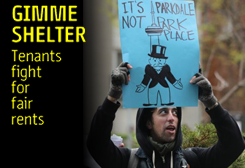WRETCHED EXCESS
Amazon boss Bezos a trillionaire soon; forces his workers to fight for fair pay

Chris Smalls, an Amazon warehouse worker in Staten Island, New York,
JEFF BEZOS HAD A GUILLOTINE in front of his house last summer. Amazon workers put it there. They wanted to remind their boss of how angry workers in the French Revolution took care of ultra rich people who ignored them.
Jeff Bezos is worth $190 billion. He is the richest person alive by far—and more. Bezos is also as rich as anyone who has ever lived. What’s more, he is on track to soon go far beyond that mark.
Trillionaire in six years
How rich is Jeff Bezos? Far, far richer than the rest of us can even begin to imagine—even if we are good at math. Consider this:
- Bezos makes $2,489 a second; an Amazon warehouse worker makes about 22 cents a second
- Bezos makes enough in just under 15 minutes than the average American man with a university degree will earn in his entire lifetime
- Bezos is so rich that spending $1.2 million for him is like an average American spending $1
- Bezos will likely become the first trillionaire in the world just six years from now, according to a study by Comparisun, a business advice platform.
Historians say the richest person who ever lived—before Bezos—was Russian Tsar Nicholas II. Workers rose up in the Russian Revolution in 1917 to dethrone and execute Tsar Nicolas II. There is little evidence that bit of history troubles Bezos. But maybe it should.
Workers organize
The Amazon Workers International (AWI) is growing fast. It is an informal network of mostly warehouse workers that brings together dozens of worker groups from the United States and six European Union countries. It is a whole new kind of worker organizing for our digital age.
There are no face-to-face meetings. Instead AWI key organizers do most of their work in videoconference sessions where “comrades” from multiple countries Zoom in to plot strategy on how to press their demands to Amazon management.
AWI is not a union. It operates on a voluntary basis, and activists pay for their annual meetings themselves. It is hard to pinpoint how many workers are part of the network, but AWI meetings before the pandemic attracted some 50 organizers from around the world.
French and Italian AWI comrades got together at the office of French union Sud Solidaires in an old railway factory in Lille, northern France last month for the AWI’s annual worldwide gathering call. Amazon workers from Poland, Germany and the United States also joined in.
The AWI online-first approach—and its emphasis on international coordination —grows out of a realization that Amazon is not your average employer. The corporation has more than 175 warehouses, or “fulfillment centers,” dotted around the world with hyper-optimized management and virulent anti-union methods. Not something traditional union strategies can easily handle.
Even during a pandemic that forced thousands of warehouse workers to brave the risk of infection, Amazon did not change its basic hardline stance against labour groups. When workers went on strike in France in May, the company temporarily shut down its warehouses in the whole country, re-routing orders via Italy.
However, there are signs AWI’s work is having an effect. Amazon has introduced 150 so-called “process changes,” like staggered breaks and shifts, since March to reduce COVID-19 risks in its warehouses.
Shining a spotlight on Amazon
The fact Amazon is in all our lives all the time can bring the company more attention than it wants. Huffington News, for example, ran an online story in 2017 urging readers to think about how Amazon workers are treated and to not shop at Amazon. The reasons given included:
- Warehouse workers are treated like robots. Workers must carry handsets that tell them what to collect and a set number of seconds to find each product. Failure to meet the targets gets a beep from the handset.
- Amazon doesn’t pay workers for every hour they work. To make sure low-wage warehouse workers don’t steal any merchandise, Amazon makes them pass through security checkpoints. This often takes up to 25 minutes—all of it unpaid.
- Warehouses are so big, as big as seven football fields, that workers use up a lot of their lunch break just walking to the cafeteria and back..
- Sometimes warehouses are so hot, people pass out.
- Amazon takes pains to make sure former employees can’t collect unemployment benefits.
- Amazon hates unions. Amazon executives categorically oppose the idea of warehouse workers organizing because they fear that unions would slow the speedy deliveries that have become the staple of the Amazon shopping experience.
Consumer addiction
Will “bad publicity”, like Amazon got from the Huffington Post story, change consumer buying habits? Readers didn’t think it would.
In one exchange, a reader agreed bad publicity was “unlikely to have any effect. For example, look at Walmart—which makes Amazon look like Mother Theresa—it gets all kinds of bad publicity, but mobs are fighting in the aisles to buy junk there too.”
- 30 -













Add new comment